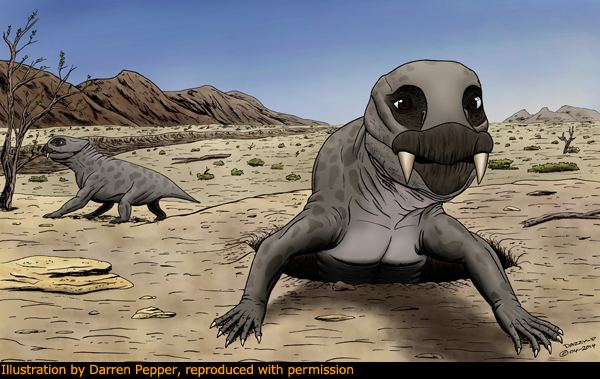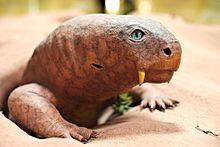Phylum Chordata Rank Genus | Infraorder †Dicynodontia Scientific name Diictodon Higher classification Pylaecephalidae Order Therapsid | |
 | ||
Similar Dicynodont, Therapsid, Dicynodon, Synapsid, Anomodont | ||
Walking with monsters diictodon and gorgonopsid
Diictodon was a genus of therapsid, roughly 45 cm (18 inches) long. It belonged to the sub-group Dicynodontia. These mammal-like synapsids lived during the Late Permian period, approximately 255 million years ago. Fossils have been found in Africa and Asia (in fact, roughly half of all Permian vertebrate specimens found in South Africa are those of Diictodon). This small herbivorous animal was one of the most successful synapsids in the Permian period.
Contents

Appearance

Diictodon had disproportionally large heads that ended in a horny beak. Both males and females had a pair of tusks sticking out from the upper jaw, with those of the male being slightly larger. Diictodon had strong arms and legs, as well as 5 sharp claws on each hand, and may have had keen senses of smell and sight. Their gait was similar to the 'high walk' of crocodiles. Their jaws were also simplified, with some of the bones dedicated instead to hearing, considered a key sign of mammalian adaptation. Diictodon also had many adaptations for digging, such as highly developed muscles, a cylindrical body, and wide hands.
Lifestyle
As a therapsid, Diictodon shared many features with modern-day mammals. Most noticeably, they made burrows into the earth. These burrows could be up to 1.5 m (5 feet) deep. Many scientists believe that Diictodon lived like the modern gopher. Their burrows could have been used to escape the heat of the desert, which was the dominant environment on the continent of Pangaea in the Late Permian Period. Inside these burrows, nests have been found, where Diictodon skeletons are present. They constituted of quite a gregarious lifestyle with numerous burrows in 500 square meters of space. However, their burrows were unconnected and did not form any large colonies. Many Diictodon nested close to flood plains, and some specimens may have been killed as water flowed into the nests, drowning the animals. Diictodon had no known rival species competing in its niche, so they may have competed primarily with others of their species for the little plant material available.
Diet
Like all dicynodonts, Diictodon were herbivorous. They used their beaks to break off pieces of the sparse desert shrubs. Like modern desert animals, Diictodon may have had unusually efficient digestive systems, due to the lack of nutrients present in desert plants. As burrowing animals, they may have fed off of water-rich plant tubers (roots).
Relatives
Diictodon was a dicynodont, and therefore only distantly related to the cynodonts that eventually evolved into mammals. Some evolved into larger species. These dicynodonts, such as Lystrosaurus and Placerias dominated the earlier part of the Triassic period. However, they were out-competed by prosauropod dinosaurs in the Norian.
